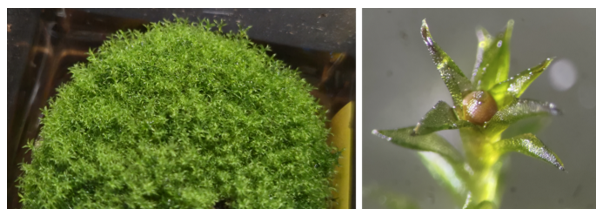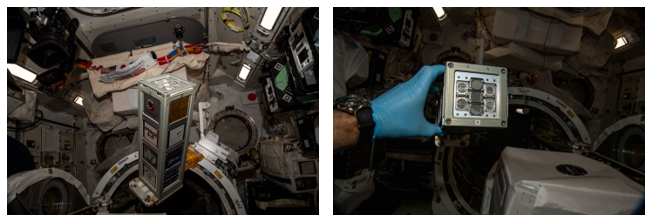Professor Atsushi Kume and his research team have demonstrated for the first time that moss spores can survive in outer space
The First Step Toward Sustainable Space Habitation
Points
- Moss Survived in Space: Viability confirmed after nine months of exposure outside the International Space Station (ISS).
- The Key to Extreme Environment Tolerance: Spores - High survival rates confirmed under ultraviolet radiation, extreme cold, and vacuum conditions.
- Contributing to Ecosystem Development on the Moon and Mars: Expected applications in plant production and life-support technologies.
Abstract
A research team comprising Dr. Chan-Hyun Maeng (Postdoctoral Researcher, Faculty of Science, Hokkaido University), Professor Tomomichi Fujita (Faculty of Science, Hokkaido University), Professor Yuji Hiwatashi (Miyagi University), Keita Nakamura (Doctoral Student), Assistant Professor Osamu Matsuda and Professor Atsushi Kume (Kyushu University), Professor Hajime Mita (Fukuoka Institute of Technology), Lecturer Kaori Tomita-Yokotani (Faculty of Life and Environmental Sciences, University of Tsukuba, at the time of research), Associate Professor Shin-ichi Yokobori and Professor Emeritus Akihiko Yamagishi (School of Life Sciences, Tokyo University of Pharmacy and Life Sciences) has demonstrated for the first time that spores of the model moss Physcomitrium patens-a reproductive structure equivalent to seeds in seed plants-can survive for extended periods in actual outer space.
Using an external experimental apparatus installed on the Japanese Experiment Module "Kibo" of the International Space Station (ISS), sporophyte,*1 containing spores of Physcomitrium patens were exposed to outer space for approximately nine months. After recovery on Earth, germination tests revealed that more than 80% of the spores germinated normally.
This is the first report to demonstrate that moss spores can survive in an actual space environment. The findings are expected to open new possibilities for constructing sustainable space ecosystems and for developing Bioregenerative Life Support Systems (BLSS)*2 that utilize living organisms.
The results of this study were published online in iScience (Cell Press) on Friday, November 21, 2025 (Japan Standard Time).
Glossary
*1 Sporophyte
In the life cycle of mosses, the sporophyte represents the diploid (2n) generation formed after fertilization. It develops at the tip of the stem and contains numerous haploid (1n) spores produced by meiosis within the capsule (sporangium). When mature, the capsule releases spores to initiate the next generation. In this study, entire sporophytes were exposed to outer space to examine their tolerance.
*2 BLSS (Bioregenerative Life Support System)
A bioregenerative life support system that utilizes the functions of living organisms such as plants and microorganisms to supply oxygen, remove carbon dioxide, recycle water and nutrients, and produce food within a closed-loop system. It is regarded as a key technology for enabling long-term stays in spacecraft or bases on the Moon and Mars.

Right: A single gametophyte with a reddish-brown, spherical capsule (sporangium) visible at the center of its upper part. The capsule contains numerous spores. Mature capsules were individually collected from gametophytes to prepare sporophyte samples, which were then exposed to outer space using the exposure facility on the International Space Station.

Right: An astronaut attaching the "Tanpopo" exposure panel to ExBAS inside the ISS. The panel contains seven exposure units holding various samples, including sporophytes of Physcomitrium patens. In this study, these samples were exposed to outer space for approximately nine months using this apparatus. (Courtesy of JAXA/NASA)
Publication Information
Title: Extreme Environmental Tolerance and Space Survivability of the Moss, Physcomitrium patens
Authors: Chang-hyun Maeng1, Yuji Hiwatashi2, Keita Nakamura3, Osamu Matsuda4, Hajime Mita5, Kaori Tomita-Yokotani6, Shin-ichi Yokobori7, Akihiko Yamagishi7, Atsushi Kume8, Tomomichi Fujita9(1 Faculty of Science, Hokkaido University, 2 School of Food Industrial Sciences, Miyagi University, 3 Graduate School of Food, Agricultural and Environmental Sciences, Miyagi University, 4 Faculty of Science, Kyushu University, 5 Department of Life, Environment and Applied Chemistry, Fukuoka Institute of Technology, 6 Faculty of Life and Environmental Sciences, University of Tsukuba, 7 School of Life Sciences, Tokyo University of Pharmacy and Life Sciences, 8 Faculty of Agriculture, Kyushu University, 9 Graduate School of Science, Hokkaido University)
Journal: iScience (an interdisciplinary scientific journal published by Cell Press)
DOI: 10.1016/j.isci.2025.113827
- For more details on this research, click here.
For Research-related inquiries












 Contact
Contact
 Access Map
Access Map

